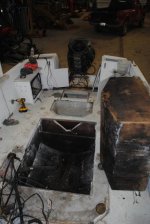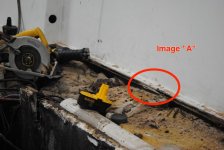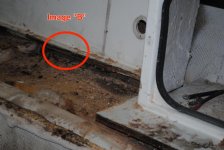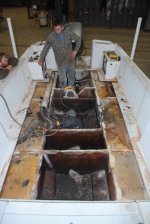Me and my buddy just picked up a 1988 V20 with a 225 Yamaha for close to nothing. When we drove 1000 miles to get her we were not surprised to find a soft sole around the t-top mounts. A surveyor on site gave the transom a thumbs up.
We spent this weekend stripping the center console, electronics, t-top and all hardware off...and will begin cutting the floor this week. Doing some knocking the stringers has me concerned but I"m very untrained on this topic. I know the sound of a good "ping" for testing transoms but hear quite a bit of "thud" on the stringers and a few spots seem delaminated when pressed on. I'm sure they will need repaired/replaced.
As we being to cut the sole I'll include many photos so you guys can assist but for now I'll just include a few links to galleries of the pre purchase and what we have seen to this point.
Here are my questions:
1) I did a quick drill of the stringer about 5 inches from the transom and 1-2 inches up from hull...seems to be no wood in there!!?!? Furthur up yes. Is this by design or should wood be butted to transom and floor in all areas before glassing?
2) I see on so many writeups/photos that many guys just cut the tops of the stringers and extract the wood. I've read about roto-tools and such but does this save any time/money? or just used as a guide/holder for the new stringer wood?
3) if the glass sides are left and wood extracted is it easy to lay the new wood down in there...shouldn't the wood be resined to the new glass or can there be air space...very confused by this technicque?
4) Do most of you take the whole stringer out or only the soft parts (keep cutting till you find good wood)? Do you have to "toe in" the new wood if you only take a part out?
I've done a lot of reading over the last two weeks and many many youtube videos but still have so many questions!
Here are photos of the pre purchase: http://www.carboncow.net/Other/Boats/1988-Wellcraft-V20-Steplift/
Here are photos of where I'm at this weekend: http://www.carboncow.net/Other/Boats/V20-Restoration-Photos/
I'll embed photos into the thread as we start cutting the sole this week. For now I have the image of the tank out. No foam. It's very strange that the tank has a hatch but cannot fit thru the hatch...we still had to cut the lip off the hatch hole. to get it out...lifted right out.
On another note I love these hulls...always wanted one but it's very interesting to see where builders cut corners and some of the questionable techniques. I can see why there are so many opinions on these boats on iboats.com and other forums! The part that really blows my mind is that 100% of everything added after the build by previous owners/dealers has no protection in cuts and screw holes...and so much bad wood because of it. Even a few of the original build cuts are questionable about sealing.
Was build quality better in the earlier boats, mid years or last years?
We spent this weekend stripping the center console, electronics, t-top and all hardware off...and will begin cutting the floor this week. Doing some knocking the stringers has me concerned but I"m very untrained on this topic. I know the sound of a good "ping" for testing transoms but hear quite a bit of "thud" on the stringers and a few spots seem delaminated when pressed on. I'm sure they will need repaired/replaced.
As we being to cut the sole I'll include many photos so you guys can assist but for now I'll just include a few links to galleries of the pre purchase and what we have seen to this point.
Here are my questions:
1) I did a quick drill of the stringer about 5 inches from the transom and 1-2 inches up from hull...seems to be no wood in there!!?!? Furthur up yes. Is this by design or should wood be butted to transom and floor in all areas before glassing?
2) I see on so many writeups/photos that many guys just cut the tops of the stringers and extract the wood. I've read about roto-tools and such but does this save any time/money? or just used as a guide/holder for the new stringer wood?
3) if the glass sides are left and wood extracted is it easy to lay the new wood down in there...shouldn't the wood be resined to the new glass or can there be air space...very confused by this technicque?
4) Do most of you take the whole stringer out or only the soft parts (keep cutting till you find good wood)? Do you have to "toe in" the new wood if you only take a part out?
I've done a lot of reading over the last two weeks and many many youtube videos but still have so many questions!
Here are photos of the pre purchase: http://www.carboncow.net/Other/Boats/1988-Wellcraft-V20-Steplift/
Here are photos of where I'm at this weekend: http://www.carboncow.net/Other/Boats/V20-Restoration-Photos/
I'll embed photos into the thread as we start cutting the sole this week. For now I have the image of the tank out. No foam. It's very strange that the tank has a hatch but cannot fit thru the hatch...we still had to cut the lip off the hatch hole. to get it out...lifted right out.
On another note I love these hulls...always wanted one but it's very interesting to see where builders cut corners and some of the questionable techniques. I can see why there are so many opinions on these boats on iboats.com and other forums! The part that really blows my mind is that 100% of everything added after the build by previous owners/dealers has no protection in cuts and screw holes...and so much bad wood because of it. Even a few of the original build cuts are questionable about sealing.
Was build quality better in the earlier boats, mid years or last years?




